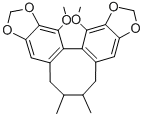Physicochemical Properties
| Molecular Formula | C22H24O6 |
| Molecular Weight | 384.42 |
| Exact Mass | 384.157 |
| Elemental Analysis | C, 68.74; H, 6.29; O, 24.97 |
| CAS # | 61301-33-5 |
| Related CAS # | Schisandrin;7432-28-2 |
| PubChem CID | 119112 |
| Appearance | White to off-white solid powder |
| Density | 1.2±0.1 g/cm3 |
| Boiling Point | 549.2±50.0 °C at 760 mmHg |
| Melting Point | 122-123ºC |
| Flash Point | 226.7±30.0 °C |
| Vapour Pressure | 0.0±1.4 mmHg at 25°C |
| Index of Refraction | 1.573 |
| LogP | 7.05 |
| Hydrogen Bond Donor Count | 0 |
| Hydrogen Bond Acceptor Count | 6 |
| Rotatable Bond Count | 2 |
| Heavy Atom Count | 28 |
| Complexity | 509 |
| Defined Atom Stereocenter Count | 0 |
| SMILES | O1C([H])([H])OC2=C1C([H])=C1C(=C2OC([H])([H])[H])C2=C(C3=C(C([H])=C2C([H])([H])[C@@]([H])(C([H])([H])[H])[C@@]([H])(C([H])([H])[H])C1([H])[H])OC([H])([H])O3)OC([H])([H])[H] |
| InChi Key | HTBWBWWADZJXID-UHFFFAOYSA-N |
| InChi Code | InChI=1S/C22H24O6/c1-11-5-13-7-15-19(27-9-25-15)21(23-3)17(13)18-14(6-12(11)2)8-16-20(22(18)24-4)28-10-26-16/h7-8,11-12H,5-6,9-10H2,1-4H3 |
| Chemical Name | 3,22-dimethoxy-12,13-dimethyl-5,7,18,20-tetraoxapentacyclo[13.7.0.02,10.04,8.017,21]docosa-1(22),2,4(8),9,15,17(21)-hexaene |
| Synonyms | Schizandrin-C; Schizandrin C |
| HS Tariff Code | 2934.99.03.00 |
| Storage |
Powder-20°C 3 years 4°C 2 years In solvent -80°C 6 months -20°C 1 month |
| Shipping Condition | Room temperature (This product is stable at ambient temperature for a few days during ordinary shipping and time spent in Customs) |
Biological Activity
| ln Vitro |
Schisandrin C (25-100 μM; 48 hours) down-regulates expression levels of Bcl-2, Bcl-xL and a concomitant degradation of poly(ADP-ribose) polymerase (PARP). Additionally, in U937 cells, it activates caspase-3 and -9[2]. Schisandrin C (25-100 μM; 48 hours) induces apoptosis in a dose-dependent manner. Additionally, U937 cells exhibit increased genomic DNA fragmentation[1]. Schisandrin C (25-100 μM; 72 hours) induces G1 arrest, down-regulates the expression of cyclin D1, cyclin E, cyclin-dependent kinase (Cdk) 4, and E2Fs, as well as inhibiting pRB and enhancing the Cdk inhibitor p21(WAF1/CIP1)[1]. |
| ln Vivo | Schisandrin C (lateral ventricle injection (i.c.v. ); 15–150 g/kg; 5 days) lessens Aβ1-42-induced memory deficits in the Y-maze test. The hippocampus' neurons in the SCH-C (15 μg/kg)-treated group recovered to normal levels, and the SCH-C group (150 μg/kg) had a minimally neuroprotective effect on the Aβ1–42-induced group. In the brains of the Aβ1–42-induced amnesic mice, SCH-C (15 μg/kg) simultaneously reduces ChEtotal levels while increasing SOD and GSHPx activities and ratios[3]. |
| Animal Protocol |
Aβ1-42-induced Alzheimer’s disease mice[3] 15-150 μg/kg Lateral ventricle injection (i.c.v.); 15-150 μg/kg; 5 days |
| References |
[1]. Induction of G1 arrest and apoptosis by schisandrin C isolated from Schizandra chinensis Baill in human leukemia U937 cells. Int J Mol Med. 2009 Oct;24(4):495-502. [2]. Anti-inflammatory effects of gomisin N, gomisin J, and schisandrin C isolated from the fruit of Schisandra chinensis. Biosci Biotechnol Biochem. 2010;74(2):285-91. [3]. Schisandrin C Ameliorates Learning and Memory Deficits by Aβ 1-42 -induced Oxidative Stress and Neurotoxicity in Mice. Phytother Res. 2015 Sep;29(9):1373-1380. [4]. Selective degradation of splicing factor CAPERα by anticancer sulfonamides. Nat Chem Biol. 2017 Jun;13(6):675-680. |
| Additional Infomation |
schisandrin C has been reported in Schisandra sphenanthera and Schisandra chinensis with data available. See also: Schisandrin C (annotation moved to). |
Solubility Data
| Solubility (In Vitro) | DMSO: 8.3~77 mg/mL (21.7~200.3 mM) |
| Solubility (In Vivo) |
Solubility in Formulation 1: ≥ 0.83 mg/mL (2.16 mM) (saturation unknown) in 10% DMSO + 40% PEG300 + 5% Tween80 + 45% Saline (add these co-solvents sequentially from left to right, and one by one), clear solution. For example, if 1 mL of working solution is to be prepared, you can add 100 μL of 8.3 mg/mL clear DMSO stock solution to 400 μL of PEG300 and mix evenly; then add 50 μL of Tween-80 to the above solution and mix evenly; then add 450 μL of normal saline to adjust the volume to 1 mL. Preparation of saline: Dissolve 0.9 g of sodium chloride in 100 mL ddH₂ O to obtain a clear solution. Solubility in Formulation 2: ≥ 0.83 mg/mL (2.16 mM) (saturation unknown) in 10% DMSO + 90% Corn Oil (add these co-solvents sequentially from left to right, and one by one), clear solution. For example, if 1 mL of working solution is to be prepared, you can add 100 μL of 8.3 mg/mL clear DMSO stock solution to 900 μL of corn oil and mix evenly. (Please use freshly prepared in vivo formulations for optimal results.) |
| Preparing Stock Solutions | 1 mg | 5 mg | 10 mg | |
| 1 mM | 2.6013 mL | 13.0066 mL | 26.0132 mL | |
| 5 mM | 0.5203 mL | 2.6013 mL | 5.2026 mL | |
| 10 mM | 0.2601 mL | 1.3007 mL | 2.6013 mL |
